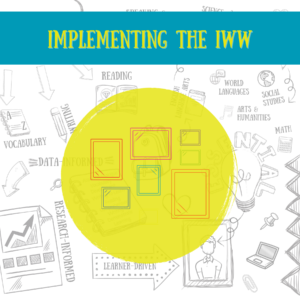STRATEGY FOCUS
Interactive Word Wall
PURPOSE
The Interactive Word Wall (IWW) is used to develop vocabulary understanding and enhance content learning. The IWW is a tool for creating activities/interactions for students to make connections between concepts, organize and track their thinking, and provide for more extended vocabulary discussion than simple definition strategies (define, match, use in a sentence, etc.). The use of the IWW has students make sense of words through representation, as well as authentic usage.

PROCESS
- Brainstorm vocabulary at the beginning of new learning by drawing on and discussing prior knowledge and have students add their words to the IWW.
- Have students skim/scan the textbook for words they are not familiar with.
- Students add words along with drawings, or other visual representations to help exhibit their understanding.
- The teacher provides a base set of Tier 2 and Tier 3 vocabulary they know are critical to success with this content.
- The teacher adds ‘terms/numbers/symbols’ that students will encounter as part of the study (i.e., AWOL in a social studies classroom, the Greek letter Δ in mathematics/science, the square root symbol √, different musical notes 𝅘𝅥, 𝇤, 𝅗𝅥 )
- Add new words as students encounter them, and/or make connections between them during their learning.
Engage students in routine interactions with the words on the IWW:
Engage students in routine interactions with the words on the IWW to help them make connections between terms, extend their understanding, and connect to new learning. Here are a few options:
- Group Connections:
-
- Student 1 gets the process started by going to the IWW, taking a term off that connects to some prompt (i.e., Which term connects to something we learned today?).
- Student 2 chooses another item that connects to student 1’s term.
- Student 3 chooses another item that connects to student 2’s term, and so on until all students have chosen a term/made a connection.
- Stringing Words Together: Small groups of students to use string or yarn to connect terms together around a prompt for the day’s learning (i.e., “We are learning about how to construct a scientific explanation based on evidence for the role of photosynthesis. What words can you connect with this concept and how?”).
- The teacher projects a diagram onto the whiteboard and students work in pairs or small groups to identify key characteristics/concepts from the IWW.
- Students work individually or collaboratively to organize vocabulary into webs, flow charts, phrases, or any other organizational structure to bring vocabulary understanding to a higher level by making connections between big ideas.
Students do a Quick Write using terms from the IWW:
- Record thoughts about new learning, using a preselected set of words that students have used during the lesson.
- Share Quick Write with a peer, listening to each other and making connections between the their thinking. Students then go back and refine their writing as a model for the revision process/continuous learning/growth mindset (this can be coupled with a whole group share out, where students share one thing they heard from their partner that they added to their thinking in order to promote active listening and paraphrasing).
Students think about their learning to this point in the unit of study (metacognitive processes):
- As an Exit Slip, students sort words into three categories: “I got it,” “I need more time,” or “Really not sure” (this provides the teacher a snapshot of student thinking and allows for intentional interaction with terms/concepts in next steps learning).
- Students identify words they think are most important to their understanding so far. This provides a piece for students to revisit as the unit of study progresses so they can keep track of their thinking and see how things have progressed. This models continuous learning and growth mindset.
- Students check prior knowledge against new understandings by regularly revisiting existing vocabulary and adding, altering, or removing language. Here are some suggested ways to do this:
a. Work individually or collaboratively to add vocabulary at any time during content studies.
b. Have students update existing representations of words/terms to refine understanding and make other connections. - Students use the Interactive Word Wall to study large bodies of content prior to demonstration of mastery.
PROBING QUESTIONS
- How does [term] connect to what we learned today?
- Can you share another way [term] connects to what we are studying?
- Can your group represent that word in another way?
CONTENT APPLICATIONS

ENGLISH
LANGUAGE ARTS
Use the Interactive Word Wall to engage in story mapping, character comparisons, discussion of genre or text features, etc.
![]()
VISUAL & PERFORMING ARTS
Use the Interactive Word Wall for the elements of art, dance, music, etc. and as you study the various time periods (Renaissance, Romanticism, Classical, etc.), discuss how those elements are seen and represented within each.
![]()
SCIENCE
After the class has developed a collective conceptual understanding of a scientific term, students create a visual representation and discuss how the word relates to other words they’ve added to the wall or used in class.
![]()
MATHEMATICS
Use the Interactive Word Wall to explore similar and dissimilar concepts, understand and discuss mathematical process vocabulary, create problem solving or algorithmic statements, classify numbers/shapes/tools, etc.
PDF Reproducible

